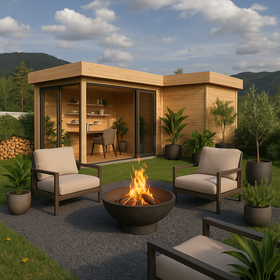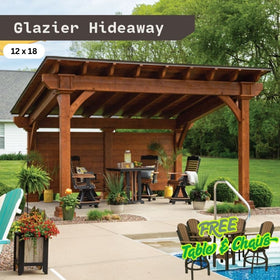512-777-0154

Man Cave vs Den: Decoding the Differences, Psychology, and Design Ideas
The idea of creating a personal retreat at home is growing fast. A man cave vs den? Some people lean toward a man cave. Others prefer the quieter style of a den. But choosing the right retreat takes personality, purpose, and a little design magic.
This guide breaks each one down so you can decide which retreat fits your world.
The Core Distinction: Purpose and Exclusivity
Choosing between a man cave and a den starts with understanding what each space is meant to do. One is open to everyone. The other is built for one person’s comfort and interests.
The Den: A Flexible, Multi-Functional, Shared Space

A den is the “whoever needs it” room in most homes. It slides into different roles depending on the day. It might hold books, a laptop, or a comfy couch.
Families use it as a second living room, a small library, or a casual workspace. Its charm comes from being relaxed, open, and easy to share.
The Man Cave: A Designated Sanctuary and Exclusive Male Retreat
A man cave is different. It is a space built for one person’s taste, hobbies, and headspace. No compromises on décor, layout, or rules. If the owner loves movie posters, classic car parts, or vintage jerseys, they’re all welcome here.
This space exists for escape, play, and personal freedom.
Decoding the Psychology of a Personal Sanctuary
Personal spaces do more than store furniture. They support mental health, give room to breathe, and let someone express who they really are. Man caves often highlight this even more.
The Need for Autonomy and Uncompromised Space

There’s something refreshing about having a room that is fully yours. A man cave gives the owner complete control. The décor. The setup. Even the snacks. Having this level of ownership helps create a sense of independence that can be hard to find in shared areas of a home.
Stress Relief and the Power of Solitude
Solitude is a powerful stress reliever. A quiet room with familiar things helps slow everything down. Whether someone watches sports, builds models, or simply sits in silence, this break from noise makes a difference. It’s a reset button that supports emotional balance.
Fostering Identity, Hobbies, and Camaraderie
A man cave also becomes a home for personal passions. It’s where collections get displayed instead of boxed up. It’s where hobbies get space to grow. It can even turn into a friendly hangout spot for movie nights or game days. These shared moments build close bonds and make the space feel alive.
Ultimate Man Cave & Den Ideas: Design, Theme, and Function
Designing these spaces can be fun. A little creativity goes a long way. Whether you want a bold theme or a simple cozy setup, there are ideas for every style.
Top Theme Ideas: From Gearhead's Haven to Gentleman's Study

Themes help guide the look and feel of a room. They also make planning easier.
Some favorites include a sports cave with team colors. A garage-style hangout filled with tools and metal signs. A home bar setup with a rustic counter. A tech-heavy gaming zone with glowing lights. Or a quiet study with soft lamps and dark wood.
Themes give identity to the space and help it feel intentional.
Integrating the Den Concept: The Multi-Functional Cave
Not everyone has a whole room to dedicate. That’s where the hybrid idea comes in.
This style blends the den’s flexibility with the man cave’s personality. A desk can share space with a TV. A reading corner can sit next to a hobby table. It’s a balanced approach for homes that need rooms to serve more than one purpose.
Essential Gear: Bar Amenities, Gaming Centers, and Display Pieces
Some items instantly level up a man cave. Plush seating makes long movie nights easier. A large TV or projector pulls the room together. Bar tools or a mini fridge make the space more inviting. A pool table, arcade cabinet, or console setup adds fun. Shelves and display cases help keep collectibles front and center.
It’s all about choosing pieces that match your interests.
The Retreat Spectrum: Locations, Alternatives, and Spelling
You can build a retreat almost anywhere. It depends on the home and how creative you want to get. Some spots become great hideaways with a little work.
Common Locations: From the Basement to the Backyard (Garage, Shed)

A man cave doesn’t need to sit in a traditional room. Basements, garages, attics, or backyard sheds often make great starting points. They offer privacy and room to add personal touches.
A den usually sits on the main level of the home. It’s more connected to everyday life and is easier for everyone to access.
The Female Counterpart: She Shed Ideas and Woman Caves
Women have their own version of the man cave. Many call it a she shed, but some prefer “woman cave”. These spaces lean toward calming colors and natural light. They work well for crafting, reading, stretching, or quiet hobbies.
The goal is the same as a man cave. A retreat that reflects the person who created it.
Spelling Guide: Man Cave (Two Words) vs. Mancave (One Word)
Both spellings show up often. “Man cave” is the traditional form. “Mancave” has become a common modern alternative. Either version is understood, so it usually comes down to personal preference.
Making the Final Choice Between a Man Cave and a Den
Both room types offer comfort, but in different ways. A man cave gives full creative freedom and a private place to unwind. A den offers flexibility and works well for families who share space.
The right choice depends on your needs, your home, and the type of retreat that feels most supportive.



